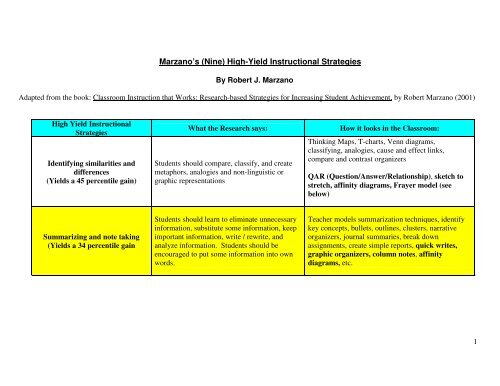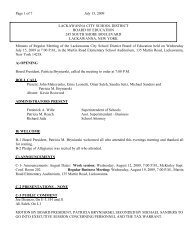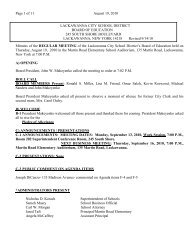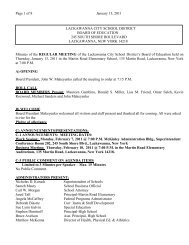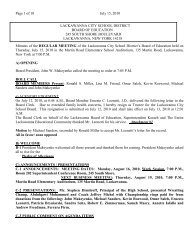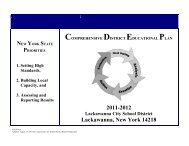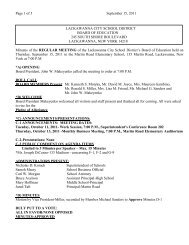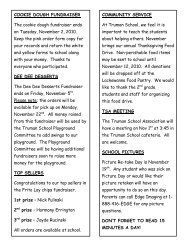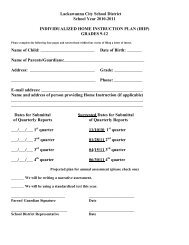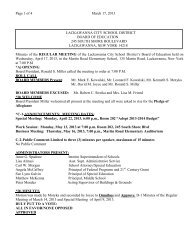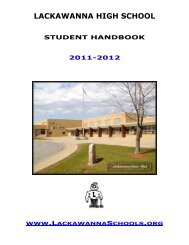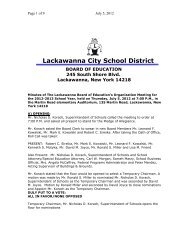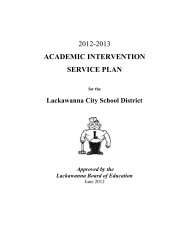Marzano's (Nine) High-Yield Instructional Strategies - Zanesville City ...
Marzano's (Nine) High-Yield Instructional Strategies - Zanesville City ...
Marzano's (Nine) High-Yield Instructional Strategies - Zanesville City ...
Create successful ePaper yourself
Turn your PDF publications into a flip-book with our unique Google optimized e-Paper software.
Marzano’s (<strong>Nine</strong>) <strong>High</strong>-<strong>Yield</strong> <strong>Instructional</strong> <strong>Strategies</strong><br />
By Robert J. Marzano<br />
Adapted from the book: Classroom Instruction that Works: Research-based <strong>Strategies</strong> for Increasing Student Achievement, by Robert Marzano (2001)<br />
<strong>High</strong> <strong>Yield</strong> <strong>Instructional</strong><br />
<strong>Strategies</strong><br />
Identifying similarities and<br />
differences<br />
(<strong>Yield</strong>s a 45 percentile gain)<br />
What the Research says:<br />
Students should compare, classify, and create<br />
metaphors, analogies and non-linguistic or<br />
graphic representations<br />
How it looks in the Classroom:<br />
Thinking Maps, T-charts, Venn diagrams,<br />
classifying, analogies, cause and effect links,<br />
compare and contrast organizers<br />
QAR (Question/Answer/Relationship), sketch to<br />
stretch, affinity diagrams, Frayer model (see<br />
below)<br />
Summarizing and note taking<br />
(<strong>Yield</strong>s a 34 percentile gain<br />
Students should learn to eliminate unnecessary<br />
information, substitute some information, keep<br />
important information, write / rewrite, and<br />
analyze information. Students should be<br />
encouraged to put some information into own<br />
words.<br />
Teacher models summarization techniques, identify<br />
key concepts, bullets, outlines, clusters, narrative<br />
organizers, journal summaries, break down<br />
assignments, create simple reports, quick writes,<br />
graphic organizers, column notes, affinity<br />
diagrams, etc.<br />
1
Reinforcing effort and providing<br />
recognition<br />
(<strong>Yield</strong>s a 29 percentile gain)<br />
Homework and practice<br />
(<strong>Yield</strong>s a 28 percentile gain)<br />
Nonlinguistic representations<br />
(<strong>Yield</strong>s a 27 percentile gain)<br />
Cooperative learning<br />
(<strong>Yield</strong>s a 23 percentile gain)<br />
Teachers should reward based on standards of<br />
performance; use symbolic recognition rather<br />
than just tangible rewards.<br />
Teachers should vary the amount of homework<br />
based on student grade level (less at the<br />
elementary level, more at the secondary level),<br />
keep parent involvement in homework to a<br />
minimum, state purpose, and, if assigned,<br />
should be debriefed.<br />
Students should create graphic representations,<br />
models, mental pictures, drawings, pictographs,<br />
and participate in kinesthetic (hands-on)<br />
activities in order to assimilate knowledge.<br />
Teachers should limit use of ability groups,<br />
keep groups small, apply strategy consistently<br />
and systematically but not overuse. Assign roles<br />
and responsibilities in groups.<br />
Hold high expectations, display finished products,<br />
praise students’ effort, encourage students to share<br />
ideas and express their thoughts, honor individual<br />
learning styles, conference individually with students,<br />
authentic portfolios, stress-free environment, highfives,<br />
Spelling Bee, Constitution Day, School<br />
Newspaper, etc.<br />
Retell, recite and review learning for the day at home,<br />
reflective journals, parents are informed of the goals<br />
and objectives, grade level teams plan together for<br />
homework distribution; SLCs; teacher email.<br />
Visual tools and manipulatives, problem-solution<br />
organizers, spider webs, diagrams, concept maps,<br />
drawings, charts, thinking maps, graphic organizers,<br />
sketch to stretch, storyboards, foldables, act out<br />
content, make physical models, etc.<br />
Integrate content and language through group<br />
engagement, reader’s theatre, pass the pencil, circle<br />
of friends, cube it, radio reading, shared reading and<br />
writing, plays, science projects, debates, jigsaw,<br />
group reports, choral reading, affinity diagrams,<br />
Students tackle TAKS word problems in groups and<br />
explain their answers, etc.<br />
Setting objectives and providing<br />
feedback<br />
(<strong>Yield</strong>s a 23 percentile gain)<br />
Teachers should create specific but flexible<br />
goals, allowing some student choice. Teacher<br />
feedback should be corrective, timely, and<br />
specific to a criterion.<br />
Articulating and displaying learning goals, KWL,<br />
contract learning goals, etc. Teacher can display<br />
objectives on the in-focus projector and follow-up on<br />
the mastery of the objective at the end of the lesson.<br />
2
Generating and testing hypothesis<br />
(<strong>Yield</strong>s a 23 percentile gain)<br />
Questions, cues, and advance<br />
organizers<br />
(<strong>Yield</strong>s a 22 percentile gain)<br />
Students should generate, explain, test and<br />
defend hypotheses using both inductive and<br />
deductive strategies through problem solving,<br />
history investigation, invention, experimental<br />
inquiry, and decision making.<br />
Teachers should use cues and questions that<br />
focus on what is important (rather than<br />
unusual), use ample wait time before accepting<br />
responses, eliciting inference and analysis.<br />
Advance organizers should focus on what is<br />
important and are more useful with information<br />
that is not well organized.<br />
Thinking processes, constructivist practices,<br />
investigate, explore, social construction of<br />
knowledge, use of inductive and deductive reasoning,<br />
questioning the author of a book, finding other<br />
ways to solve same math problem, etc.<br />
Graphic organizers, provide guiding questions<br />
before each lesson, think alouds, inferencing,<br />
predicting, drawing conclusions, skim chapters to<br />
identify key vocabulary, concepts and skills,<br />
foldables, annotating the text, etc.<br />
HIGH-YIELD INSTRUCTIONAL<br />
STRATEGIES<br />
SIMILARITIES AND DIFFERENCES<br />
There are four basic types of tasks that<br />
focus on identifying similarities and<br />
differences for knowledge<br />
development:<br />
Comparing<br />
Classifying<br />
Creating Metaphors<br />
Creating Analogies<br />
Identifying similarities and differences<br />
T-Chart<br />
Looks like………...Sounds like<br />
Cause……………..Effect<br />
Compare…………...Contrast<br />
Pro…………….Con<br />
Identifying similarities and differences<br />
Attribute 1<br />
Attribute 2<br />
Attribute 3<br />
Comparison Matrix<br />
Name 1 Name 2<br />
Used to show similarities and differences<br />
between two things (people, places, events,<br />
ideas, etc.).<br />
Key frame questions: What things are being<br />
compared?<br />
How are they similar? How are they<br />
different?<br />
Identifying similarities and differences<br />
3
Cause and Effect Links<br />
A cause is something that makes something else happen. Out of two events,<br />
it is the event that happens first. To determine the cause, ask the question "Why did it happen?"<br />
--------------<br />
An effect is what happens as a result of the cause. Of two related events,<br />
it’s the one that happens second or last. To determine the effect, ask the question "What happened?"<br />
---------------<br />
At times conjunctions (connecting words) are used to link the cause and effect.<br />
Examples of common conjunctions (connecting words) are:<br />
--------------------<br />
since as a result because the cause of<br />
therefore consequently due to the fact nevertheless<br />
the reason for thus so has led to<br />
due to + noun phrase because of +noun phrase<br />
Identifying similarities and differences<br />
Venn Diagrams<br />
Compare and Contrast<br />
Text/Character Comparison<br />
Definition<br />
Frayer Model<br />
Illustration<br />
unique<br />
same<br />
unique<br />
The Life<br />
Events of:<br />
Me, Too<br />
Explanation<br />
Word/Phrase/<br />
Concept<br />
Example<br />
Non-example<br />
Identifying similarities and differences<br />
Identifying similarities and differences<br />
Identifying similarities and differences<br />
4
Sketch to Stretch<br />
1. Students listen as a story, article, or poem is read to them.<br />
2. Students draw a picture that expresses:<br />
• how the story, article or poem makes them feel<br />
• what they think story, article or poem story means<br />
• what they think the author looks like<br />
• anything that comes to mind during the reading<br />
Question/Answer/Relationships (QAR)<br />
(Also related to “Book and Brain”)<br />
“Right there”<br />
(in the text)<br />
--book ques.--<br />
“Think and Search”<br />
(text + my thinking)<br />
--book and brain--<br />
“In my head”<br />
(my thinking<br />
only)<br />
--brain ques.--<br />
--have to infer<br />
3. Students explain their drawing to a partner/small group.<br />
The class discusses the similarities/differences in their pictures.<br />
Identifying similarities and differences<br />
Classifying<br />
Comparing Frame<br />
FRACTIONS and DECIMALS are similar<br />
because they both<br />
_______________________________<br />
_______________________________<br />
_______________________________<br />
Creating Analogies<br />
Analogies help us see how seemingly<br />
dissimilar things are similar, increasing<br />
our understanding of new information.<br />
Ex: core is to earth as nucleus is to atom.<br />
__ate family __at family<br />
Sort the word cards (or pictures)<br />
into the correct bucket.<br />
Identifying similarities and differences<br />
FRACTIONS and DECIMALS are different<br />
because<br />
fractions ________, but decimals ________.<br />
fractions ________, but decimals ________.<br />
fractions ________, but decimals ________.<br />
Identifying similarities and differences<br />
Thermometer ...is to...Temperature<br />
as<br />
odometer ...is to...speed<br />
(Both measure things)<br />
Identifying similarities and differences<br />
5


